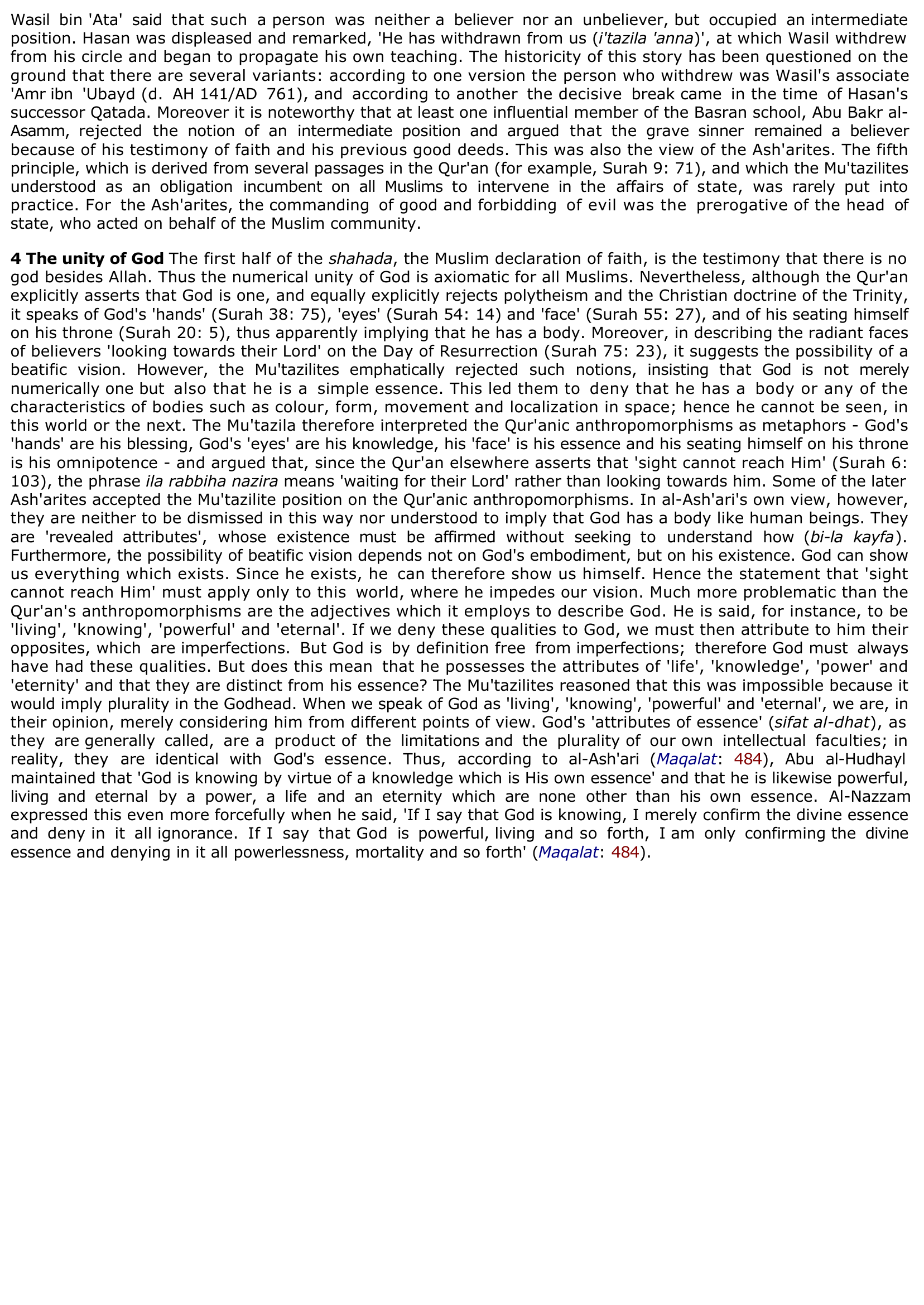Ash'ariyya and Mu'tazila
Publié le 22/02/2012

Extrait du document
«
Wasil bin 'Ata' said that such a person was neither a believer nor an unbeliever, but occupied an intermediateposition.
Hasan was displeased and remarked, 'He has withdrawn from us ( i'tazila 'anna )', at which Wasil withdrew from his circle and began to propagate his own teaching.
The historicity of this story has been questioned on theground that there are several variants: according to one version the person who withdrew was Wasil's associate'Amr ibn 'Ubayd (d.
AH 141/AD 761), and according to another the decisive break came in the time of Hasan'ssuccessor Qatada.
Moreover it is noteworthy that at least one influential member of the Basran school, Abu Bakr al-Asamm, rejected the notion of an intermediate position and argued that the grave sinner remained a believerbecause of his testimony of faith and his previous good deeds.
This was also the view of the Ash'arites.
The fifthprinciple, which is derived from several passages in the Qur'an (for example, Surah 9: 71), and which the Mu'tazilitesunderstood as an obligation incumbent on all Muslims to intervene in the affairs of state, was rarely put intopractice.
For the Ash'arites, the commanding of good and forbidding of evil was the prerogative of the head ofstate, who acted on behalf of the Muslim community.
4 The unity of God The first half of the shahada , the Muslim declaration of faith, is the testimony that there is no god besides Allah.
Thus the numerical unity of God is axiomatic for all Muslims.
Nevertheless, although the Qur'anexplicitly asserts that God is one, and equally explicitly rejects polytheism and the Christian doctrine of the Trinity,it speaks of God's 'hands' (Surah 38: 75), 'eyes' (Surah 54: 14) and 'face' (Surah 55: 27), and of his seating himselfon his throne (Surah 20: 5), thus apparently implying that he has a body.
Moreover, in describing the radiant facesof believers 'looking towards their Lord' on the Day of Resurrection (Surah 75: 23), it suggests the possibility of abeatific vision.
However, the Mu'tazilites emphatically rejected such notions, insisting that God is not merelynumerically one but also that he is a simple essence.
This led them to deny that he has a body or any of thecharacteristics of bodies such as colour, form, movement and localization in space; hence he cannot be seen, inthis world or the next.
The Mu'tazila therefore interpreted the Qur'anic anthropomorphisms as metaphors - God's'hands' are his blessing, God's 'eyes' are his knowledge, his 'face' is his essence and his seating himself on his throneis his omnipotence - and argued that, since the Qur'an elsewhere asserts that 'sight cannot reach Him' (Surah 6:103), the phrase ila rabbiha nazira means 'waiting for their Lord' rather than looking towards him.
Some of the later Ash'arites accepted the Mu'tazilite position on the Qur'anic anthropomorphisms.
In al-Ash'ari's own view, however,they are neither to be dismissed in this way nor understood to imply that God has a body like human beings.
Theyare 'revealed attributes', whose existence must be affirmed without seeking to understand how ( bi-la kayfa ). Furthermore, the possibility of beatific vision depends not on God's embodiment, but on his existence.
God can showus everything which exists.
Since he exists, he can therefore show us himself.
Hence the statement that 'sightcannot reach Him' must apply only to this world, where he impedes our vision.
Much more problematic than theQur'an's anthropomorphisms are the adjectives which it employs to describe God.
He is said, for instance, to be'living', 'knowing', 'powerful' and 'eternal'.
If we deny these qualities to God, we must then attribute to him theiropposites, which are imperfections.
But God is by definition free from imperfections; therefore God must alwayshave had these qualities.
But does this mean that he possesses the attributes of 'life', 'knowledge', 'power' and'eternity' and that they are distinct from his essence? The Mu'tazilites reasoned that this was impossible because itwould imply plurality in the Godhead.
When we speak of God as 'living', 'knowing', 'powerful' and 'eternal', we are, intheir opinion, merely considering him from different points of view.
God's 'attributes of essence' ( sifat al-dhat ), as they are generally called, are a product of the limitations and the plurality of our own intellectual faculties; inreality, they are identical with God's essence.
Thus, according to al-Ash'ari ( Maqalat : 484 ), Abu al-Hudhayl maintained that 'God is knowing by virtue of a knowledge which is His own essence' and that he is likewise powerful,living and eternal by a power, a life and an eternity which are none other than his own essence.
Al-Nazzamexpressed this even more forcefully when he said, 'If I say that God is knowing, I merely confirm the divine essenceand deny in it all ignorance.
If I say that God is powerful, living and so forth, I am only confirming the divineessence and denying in it all powerlessness, mortality and so forth' ( Maqalat : 484 )..
»
↓↓↓ APERÇU DU DOCUMENT ↓↓↓
Liens utiles
- Ideology and Rationality in the History of the Life Sciences
- Relationship between religion, spirituality, and young Lebanese university students’ well-being.
- Course of reading and writing for 1st year English Licence
- dance and the different types of choreographie process
- Fiche de lecture sur le chapitre 11: The Greek of the New Testament, par Mark Janse, sur la section IV de l’ouvrage, intitulé: Ancient Greek: structure and change, pages 646-653.

































